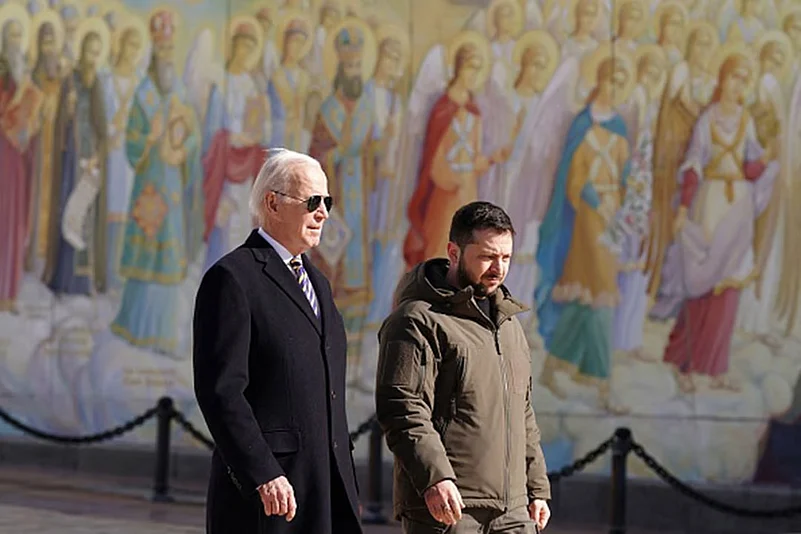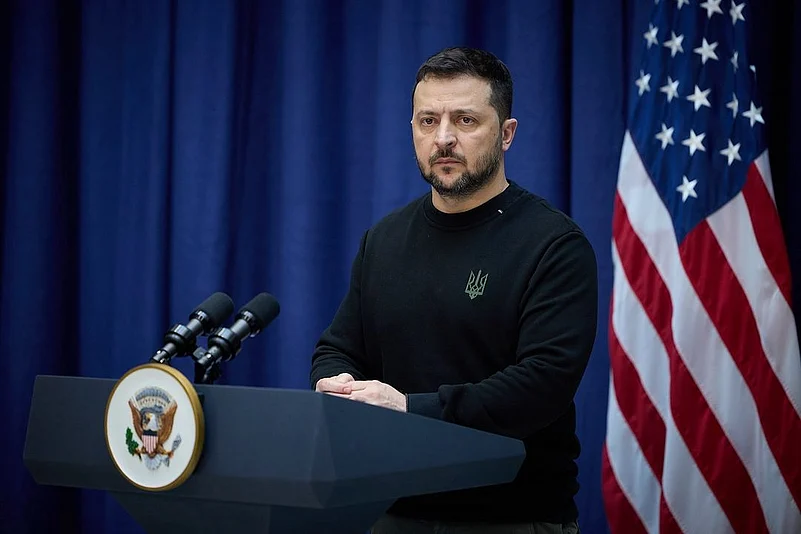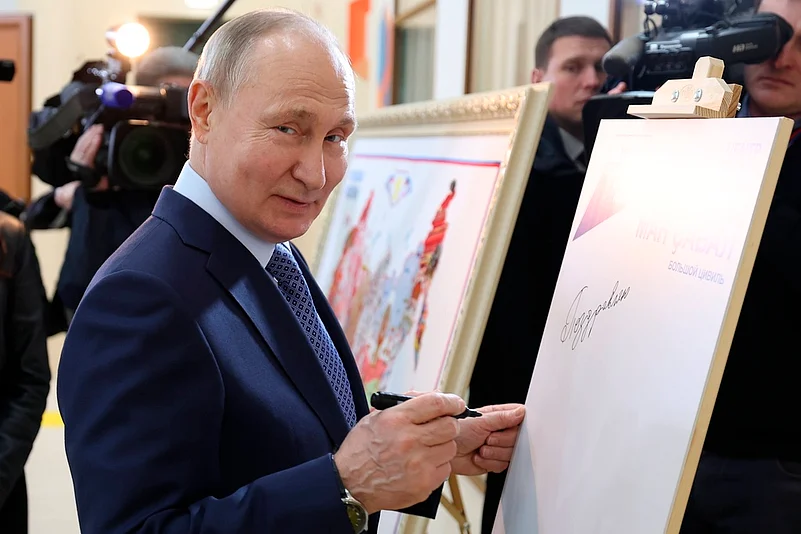As the Russian invasion of Ukraine touches the two-year mark, Russian President Vladimir Putin and the West are locked in a blinking game.
For now, Putin would want to believe he is winning the Ukraine War which has turned into a grinding war of attrition. His troops have just secured their biggest victory in a year in Avdiivka in eastern Ukraine and the US aid to Ukraine, which has been critical to the country’s defence, remains stalled as the far-right flank of the Republican Party refuses to approve the aid in the US House of Representatives, the lower house of the US Congress.
Such a situation is in sharp contrast with the optimism in favour of Ukraine this time last year when US President Joe Biden made a surprise visit to the country, becoming the first President of the United States to visit an active warzone in over a century. In Kyiv, he reiterated the “unwavering and unflagging commitment to Ukraine’s democracy, sovereignty, and territorial integrity”. A year later, the assessments are much more sober.
European affairs expert Swasti Rao says the unabashed optimism favouring Ukraine at the end of the first year of the war has now turned into a much more realistic point of view.
“While the battlefield has been more or less stagnant in recent months and Russia has scored victories like the one at Avdiivka, there has been an unmissable overall weakening of Russia. Ukraine has had huge success in the Black Sea where it has dealt unprecedented damage to the Russian fleet. In recent months, Ukraine has also carried out strikes deeper in Russia and Russia-held Ukrainian territories at strategic targets. Avdiivka has also come with a very high human cost to Russia. The Russian economy is much more dependent on China amid international isolation unseen so far. For these reasons, there is little pessimism at the moment but a lot of realism,” says Rao, an Associate Fellow at the Europe and Eurasia Center at the think tank Manohar Parrikar Institute for Defence Studies and Analyses (MP-IDSA).

How Things Stand In Ukraine War
At the onset, it might appear that Russian President Vladimir Putin is winning. After all, Russia has just scored the biggest victory in Avdiivka since Bakhmut, Putin is unchallenged domestically after the deaths of mutinous Wagner Group chief Yevgeny Prigozhin and critic Alexei Navalny, and the Russian economy has been resilient in the face of Western sanctions. But the reality is not as clear.
The victory at Avdiivka, for one, came at a very high cost to Russia, just like Bakhmut last year, which was the bloodiest battle of the war. In Avdiivka, Western estimates say Russia lost around 17,000 soldiers and the overall casualties could be in 40,000s.
Unlike the 2022-23 counter-offensive mounted by the Ukrainians, which recaptured large swathes of Russia-held territories in Ukraine’s southeast, the 2023 counter-offensive could not produce any sweeping outcomes. The reasons have varied from lack of weaponry for assaults to much better Russian defensive lines which ensured that the Russian forces withstood this round of offensive better than 2022-23. They dug in multiple lines of trenches, set up anti-tank and anti-armour obstacles, and fended off the Ukrainian advances much better than the last time.
As for the Russian economy, while it has fared relatively well in the wake of the sanctions, mostly on the back of selling gas and petroleum by bypassing Western pressure, it has become much more dependent on China, which has affected its resilience. Now, Russia is using up to 6 per cent of its gross domestic product (GDP) and around 40 per cent of its budget for the war. As the domestic military industry is under strain, it is importing artillery shells from North Korea and drones from Iran. For other defence goods and the majority of consumer goods and technological requirements, Russia has become dependent on China as it has been isolated from the West because of sanctions.
On the battlefront, significant fighting is going on in the Ukrainian cities of Kupyansk, Toretsk, Pervomaisk, Nevelske, and Marinka in the eastern part of the country, according to the latest updates from the Institute for the Study of War (ISW).
As per the ISW, the available evidence indicates that Russian forces advanced south of Bohdanivka, in the eastern outskirts of Ivanivske, towards Lastochkyne, and to the south of Krasnohorivka in eastern Ukraine.
Instead of focusing on the entire length and breadth of the battlefield, Ukraine appears to be picking battles it can win, defending as much land as it can, and laying the groundwork for any future counter-offensives. In the absence of fresh US weaponry, the artillery-dependent Ukrainian military has had to hold off its offensive plans and focus on the defensive. If US supplies don’t restart by April, though, the Ukrainian military may be facing “critical” shortages, according to US estimates.

Ukraine War Has Changed Europe
The security architecture of Europe has been reshaped by the double whammy of the Ukraine War and the possibility of a second term for Donald Trump, who has a high chance of winning this year’s election in the United States.
Putin’s war on Ukraine has fundamentally upended the post-World War II security architecture of Europe. Such conventional fighting had not been seen since World War II when Hitler plunged the continent into death and destruction. Now, Europe has got reality checks about its place in the world. Over the decades, it had developed complacency by outsourcing its energy requirements to Russia, its security needs to the United States, and its economic needs to China. Now, that phase is over for Europe and it is scrambling to adapt to the new world order on a war footing — literally.
As Trump has signalled to turn the United States protectionist and isolationist under a second term, Europe is also scrambling to ‘Trump-proofing’ the continent. The North Atlantic Treaty Organization (NATO) countries are scrambling to boost their posturing and preparing for the eventuality of a Trump presidency slashing the US funding to the bloc.
Even as Europe finds itself stretched to ramp up defence industrial production and boost military spending, it is not going to give up on Ukraine even if the United States does, says Swasti Rao of the think tank MP-IDSA.
Rao tells Outlook that “Ukraine will not be Europe’s Afghanistan” as it is its own turf and the Russian challenge is the biggest the continent has faced since World War II and is existential in nature.
“European countries are already entering into bilateral security agreements with Ukraine. Germany has emerged as the second-largest donor to Ukraine. There is no leaving Ukraine for European countries. They are in it till the very end. Though it needs to be seen if they can substantially make up for retreat of the United States from the scene if Trump pulls the plug on funding Ukraine or NATO,” says Rao.
What’s Endgame In Ukraine War?
Like all wars, the Ukraine War should also end on the negotiating table, but it should not end any time soon.
For one, Russian President Vladimir Putin thinks he is winning and sees no reason not to continue. His best-case scenario is that the far-right flank of the Republican Party will continue to stop US military aid to Ukraine, Donald Trump will become the President of the United States next year and pull the plug on Ukraine aid, and then Russia will either make the push to capture Ukraine as a whole or arm-twist Ukraine into surrender at the negotiating table.
For now, both Ukraine and Russia project maximalist objectives. While Ukraine maintains it will retake all of its territories, Russia continues with the rhetoric of “denzaification of Ukraine” and complete victory. In Putin’s worldview, Ukraine never existed as an independent country and Ukraine is therefore fighting an existential war.
The Ukrainians understand that their maximalist objectives are not entirely realistic and their war efforts are aimed at arriving at a battlefield equilibrium that gives them an upper hand in negotiations whenever the two sides arrive at the negotiating table.

Swasti Rao of the MP-IDSA does not see such talks happening before 2026 because Putin will not relent before the US presidential election results and will further test the new presidency of Donald Trump or the second term of Joe Biden.
“Realistically speaking, it seems difficult to imagine that 1991 borders can be restored for Ukraine. The war is to have a position of strength at the negotiating table. In any talks with Russia, the country’s assets frozen in Europe will be a key bargaining chip. For European countries and Ukraine to be able to pull that off, Ukraine needs to be in a militarily better position in the war and Russia needs to be much weaker, none of which is happening anytime soon,” says Rao.
For now, the war will continue. While Ukraine is bound by its partners dealing with the chaos that comes with being a democracy, Russia and its fellow autocratic partners in North Korea, China, or Iran have no such qualms. This means that while the US partisan politics delays the US aid to Ukraine and European leaders build consensus as to how to better respond to the situation, the Russian partners simply deliver what they can because there is no opposition to be taken into confidence or democratic consensus to be sought.
In the Ukraine War, Putin is counting on the chaotic democracies buckling and the unity of autocracies prevailing. In the blinking game with the West, he looks set to be in the long haul with the goal of waiting out the Western patience. Whether it’s his axis of autocracies that wins or the West, only time will tell.
















